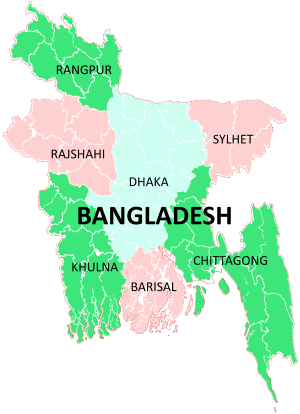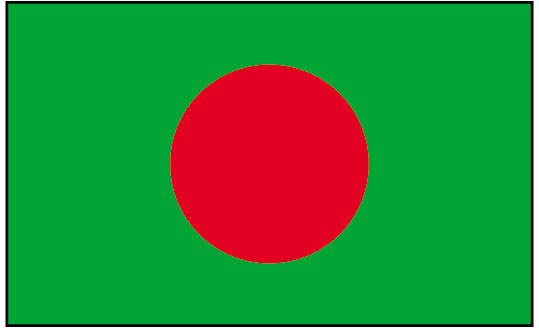Bangladesh (Bengali: গণপ্রজাতন্ত্রী
বাংলাদেশ Gônoprojatontri Bangladesh) is a
sovereign state located in South
Asia. It is bordered by India
and Burma and by the Bay of Bengal to the south. The capital (and largest
city) is Dhaka, located in central
Bangladesh. The official state language is Bengali.
The name Bangladesh means "Land of Bengal" or "Country of
Bengal" in the Bengali language, from Bangla"Bengal"
and desh holding a dual meaning of "land" and
"country".
The borders of present-day Bangladesh were established with the partition of Bengal during the reign and demise of the
British India. Its map was chartered by Sir
Cyril Radcliffe during the creation
of Pakistan and India in 1947, when the region became East Pakistan, part of the newly
formed nation of Pakistan. Due to
political exclusion and economic exploitation by the politically dominant West
Pakistan, popular agitation grew against West
Pakistan and led to the Bangladesh Liberation War in 1971, after the Bangladeshi Declaration of
Independence on 26 March 1971.With
the intervention of the Indian Army,
the war came to an end on 16 December 1971 with the surrender of the Pakistan Army at Ramna
Race Course.
Bangladesh is a parliamentary
democracy, with an elected parliament called the Jatiyo Sangshad. It is the eighth-most populous country and among the most densely populated countries in the world. Just like in the rest of
South Asia the poverty rate prevails, although the United Nations has acclaimed
Bangladesh for achieving tremendous progress in human development. Geographically, the country straddles
the fertile Ganges-Brahmaputra Delta and is subject to annual monsoon floods and cyclones.
 The country is listed among the Next
Eleven economies. It is a founding member of the South Asian Association for Regional
Cooperation, BCIM, the Developing 8 Countries and BIMSTEC, and a member of the Commonwealth of Nations, the Organisation of Islamic Cooperationand
the Non-Aligned Movement. However,
Bangladesh continues to face a number of major challenges, including widespread
political and bureaucratic corruption, widespread poverty, and an increasing
danger of hydrologic shocks brought on by ecological vulnerability to climate change.
The country is listed among the Next
Eleven economies. It is a founding member of the South Asian Association for Regional
Cooperation, BCIM, the Developing 8 Countries and BIMSTEC, and a member of the Commonwealth of Nations, the Organisation of Islamic Cooperationand
the Non-Aligned Movement. However,
Bangladesh continues to face a number of major challenges, including widespread
political and bureaucratic corruption, widespread poverty, and an increasing
danger of hydrologic shocks brought on by ecological vulnerability to climate change.
Remnants of civilization in the greater Bengal region date back four thousand years, when the region was settled by Dravidian, Tibeto-Burman, and Austro-Asiatic peoples. The exact origin of the word "Bangla" or "Bengal" is not known, though it is believed to be derived from Bang, the Dravidian-speaking tribe that settled in the area around the year 1000 BCE.
Bangladesh is divided into seven administrative divisions, each named
after their respective divisional
headquarters:Barisal, Chittagong, Dhaka, Khulna, Rajshahi, Sylhet and Rangpur.
Divisions are subdivided into districts (zila). There are 64
districts in Bangladesh, each further subdivided into upazila(subdistricts)
or thana. The area within each police station, except for those in
metropolitan areas, is divided into severalunions, with each union
consisting of multiple villages. In the metropolitan areas, police stations are
divided into wards, which are further divided into mahallas. There are no
elected officials at the divisional or district levels, and the administration
is composed only of government officials. Direct elections are held for each
union (or ward), electing a chairperson and a number of members. In 1997, a
parliamentary act was passed to reserve three seats (out of 12) in every union
for female candidates.
Dhaka is the capital and largest city of Bangladesh. Other major cities
include Chittagong, Khulna, Rajshahi, Sylhet, Barisal,Bogra, Comilla, Mymensingh and Rangpur.
These cities have mayoral elections, while other municipalities elect a
chairperson. Mayors and chairpersons are elected for a span of five years.
Bangladesh lies between latitudes 20° and 27°N, and longitudes 88° and 93°E.
Bangladesh is in the low-lying Ganges–Brahmaputra River Delta or Ganges Delta. This delta is formed by the confluence of the Ganges (local name Padma or Pôdda), Brahmaputra (Jamuna or Jomuna also known as "Yamuna"), and Meghna rivers and their respective tributaries. The Ganges unites with the Jamuna (main channel of the Brahmaputra) and later joins the Meghna to eventually empty into the Bay of Bengal. The alluvial soil deposited by these rivers has created some of the most fertile plains in the world. Bangladesh has 57 trans-boundary rivers, making water issues politically complicated to resolve – in most cases as the lower riparian state to India. Most parts of Bangladesh are less than 12 m (39.4 ft) above the sea level, and it is believed that about 10% of the land would be flooded if the sea level were to rise by 1 m (3.28 ft).
The population of Bangladesh at 15 March 2011 is 142.3 million (census 2011 results; this is a preliminary figure which has been disputed by the UN and now by Bangladeshis themselves), much less than recent (2007–2010) estimates of Bangladesh's population range from 158 to 170 million and it is the 8th most populous nation in the world. In 1951, the population was 44 million. It is also the most densely populated large country in the world, and it ranks 11th in population density, when very small countries and city-states are included. A striking contrast is offered by Russia which has a slightly smaller population spread over a land area that is 120 times larger than Bangladesh. Bangladesh's population growth was among the highest in the world in the 1960s and 1970s, when the country swelled from 65 to 110 million. With the promotion of birth control in the 1980s, the growth rate had slowed. The population is relatively young, with 60% being 25 or younger and 3% being 63 or older. Life expectancy at birth is estimated to be 70 years for both males and females in 2012.
Early all Bangladeshis speak Bengali as their mother tongue as it is the official language.It is an Indo-Aryan language of Sanskritorigin with its own script. English is used as a second language among the middle and upper classes. English is also widely used in higher education and the legal system. Historically, laws were written in English and were not translated into Bengali until 1987 when the procedure was reversed. The Bihari population speaks Urdu, which was also the language associated with the government prior to separation from Pakistan.
Health and education levels remain relatively low, although they have improved recently as poverty (31% at 2010) levels have decreased. Most Bangladeshis continue to live on subsistence farming in rural villages. For those in rural areas, village doctors with little or no formal training constitute 62% of the healthcare providers practising modern medicine and the formally trained providers are occupying a mere 4% of the total health workforce. A survey conducted by Future Health Systems revealed significant deficiencies in treatment practices of village doctors, with a wide prevalence of harmful and inappropriate drug prescriptions. There are market incentives for accessing health care through informal providers and it is important to understand these markets in order to facilitate collaboration across actors and institutions in order to provide incentives for better performance.
A 2007 study of 1000 households in rural Bangladesh found that direct costs (payment to formal and informal health care providers) and indirect costs (loss of earnings associated with workdays lost due to illness) associated with illness were important deterrents to accessing health care from qualified healthcare providers. A community survey with 6183 individuals in rural Bangladesh found a clear gender difference in treatment seeking behaviour, with women less likely to seek treatment compared to men. The use of skilled birth attendants, however, has risen between 2005 and 2007 by women in all wealth quintiles except the highest quintile. A pilot community empowerment tool, called a health watch, was successfully developed and implemented in south-eastern Bangladesh in order to improve uptake and monitoring of public health services.
The poor health conditions in Bangladesh is attributed by the lack of healthcare and services provision by the government. The total expenditure on healthcare as a percentage of their GDP was only 3.35% in 2009, according to a World Bank report published in 2010. The number of hospital beds per 10 000 population is 4. The General government expenditure on healthcare as a percentage of total government expenditure was only 7.9% as of 2009 and the citizens pay most of their health care bills as the out-of-pocket expenditure as a percentage of private expenditure on health is 96.5%.
The educational system in Bangladesh is three-tiered and highly subsidised. The government of Bangladesh operates many schools in the primary, secondary, and higher secondary levels. It also subsidises parts of the funding for many private schools. In the tertiary education sector, the government also funds more than 15 state universities through the University Grants Commission.
Primary (from grades 1 to 5), Junior Secondary (from grades 6 to 8), Secondary (from grades 9 to 10), Higher Secondary (from grades 11 to 12) and tertiary. The five years of lower secondary education concludes with a Secondary School Certificate (SSC) Examination but since 2009 it concludes with a Primary Education Closing (PEC) Examination. Also earlier Students who pass this examination proceed to four years Secondary or matriculation training, which culminate in a Secondary School Certificate (SSC) Examination but since 2010 the Primary Education Closing (PEC) passed examinees proceed to three years Junior Secondary, which culminate in a Junior School Certificate (JSC) Examination. Then students who pass this examination proceed to two years Secondary or matriculation training, which culminate in a Secondary School Certificate (SSC) Examination. Students who pass this examination proceed to two years of Higher Secondary or intermediate training, which culminate in a Higher Secondary Certificate (HSC) Examination. Education is mainly offered in Bengali, but English is also commonly taught and used. A large number of Muslim families send their children to attend part-time courses or even to pursue full-time religious education, which is imparted in Bengali and Arabic in madrasahs.
Source: www.wikipedia.org